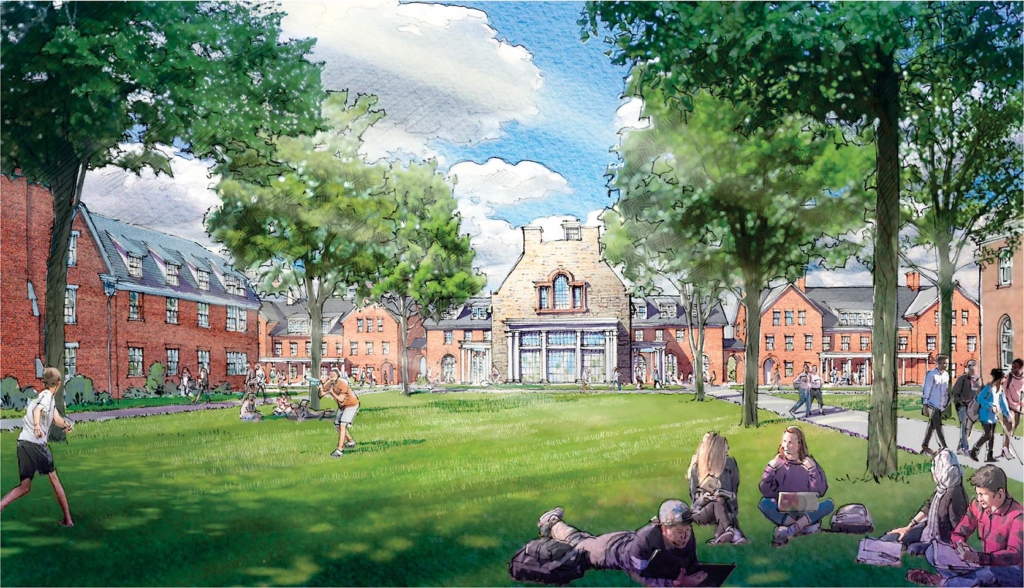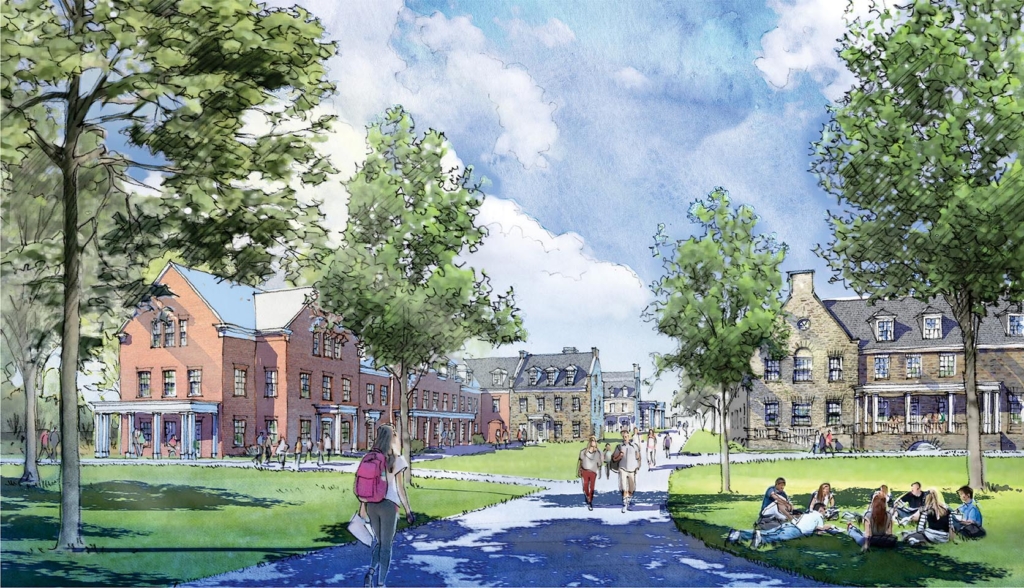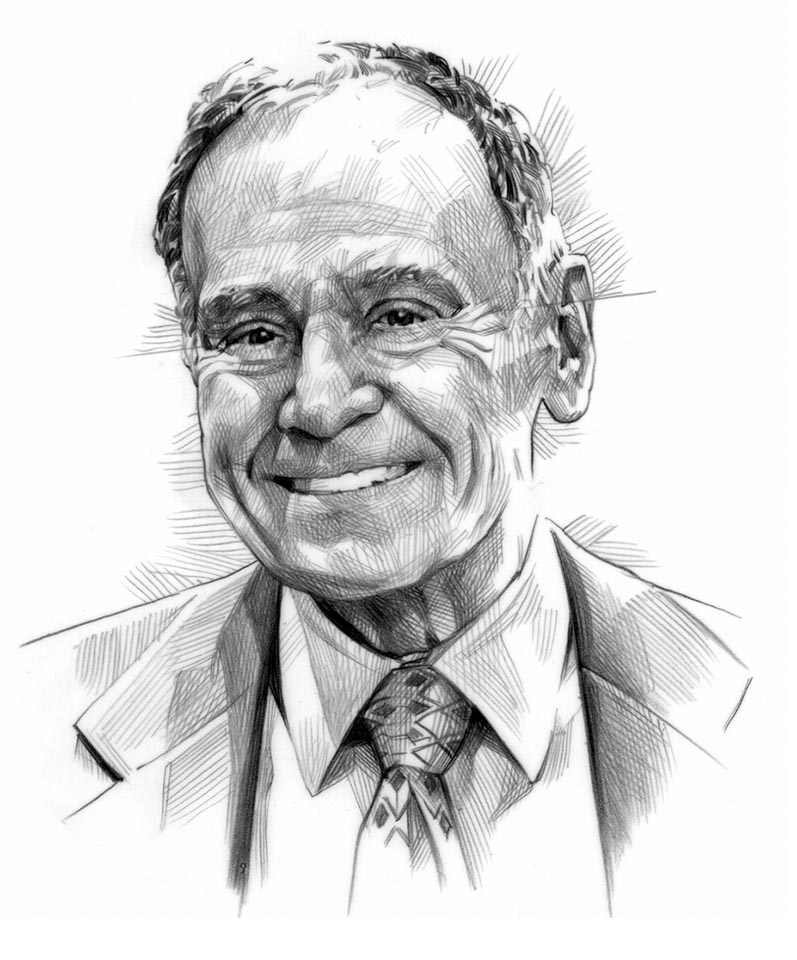Colgate is rebuilding and renovating housing for juniors and seniors, creating a new campus region.
At Colgate, the academic quadrangle is our village green — grassy, shaded, and bordered by buildings that belong on postcards. The Middle Campus is on its way to becoming an arts, creativity, and innovation district. The west side of Broad Street, at the south entrance to the campus, will continue to be the home of Colgate athletics, with its arenas, fields, and training centers.
Meanwhile, different forms of housing, in various states of repair, dot College and Broad streets. In spite of their proximity to campus, they can seem disorganized, distinct, and distant from Colgate’s physical core. Through a massive, multiyear investment in student life, the University is about to create a new campus neighborhood there. It is called the Lower Campus, and it stretches from Phi Delta Theta to the south, past Bunche House and the Loj, toward Kappa Kappa Gamma on the northern edge.
Once this ambitious set of Third-Century priorities is realized, all first- and second-year students will join a completed Residential Commons system atop the Hill. As juniors and seniors, they will move into Lower Campus theme houses, fraternity houses, sorority houses, apartments, and townhouses. They will certainly sleep in these spaces, but they will also form friendships, collaborate, socialize, cooperate, eat together, and continue to build on the knowledge they gained in the classroom.
This kind of community is available to a portion of the student body today. New buildings and renovations will make it universal as Colgate doubles down on its commitment to residential life within its liberal arts tradition.
We will always engage in long-term planning, seeking sustained change. It is so easy to do quick things, but we will take the longer-term view.
President Brian W. Casey
The Big Picture
In the early 2000s, Colgate purchased the fraternity and sorority houses along Broad Street. These chapter houses joined theme houses, such as the Loj and Creative Arts House, on the list of living options for juniors and seniors. A comprehensive review of Broad Street housing in 2006 identified these buildings’ extensive renovation needs, but work paused for leadership transitions and subsequent strategic planning. Deferred maintenance mounted. President Brian W. Casey arrived in 2016 and wanted to take a look at this neighborhood as the long-term strategic plan for the University emerged. Why not think of the area holistically, rather than as 17 individual renovation projects? The neighborhood — including the addition of a new West Row of housing, to be located behind the traditional houses along Broad Street — would become a place where more Colgate students could live together in community.
The Lower Campus became the subject of close study by some of the nation’s leading architecture and landscape experts as well as the New York State Department of Environmental Conservation and the U.S. Army Corps of Engineers. These planning efforts led to a comprehensive physical plan for the Lower Campus, showing Broad Street as it is and how it could be. Old Broad Street is still there. You can see it in 76 Broad, Delta Upsilon, Bunche House, and Gamma Phi Beta or “Little Blue.” But so is the collective potential of structures that, together, will house more than 1,000 Colgate juniors and seniors in a way that simultaneously promotes community and a sense of a campus.
“For upper-level students, Colgate will create a distinctive and cohesive residential experience that is a developmentally appropriate extension of their first two years living on the campus,” says Vice President and Dean of the College Paul J. McLoughlin II.
A Walking Tour
Let’s start at 66 Broad Street (the chapter house of Delta Upsilon, or Porter House, depending on your graduation year), because that’s what the University itself is doing. Students who would normally live in this house will be relocated to other spaces for a year, and construction crews will walk the hallways instead, removing everything in their path, down to the wall studs.

“This is not just deferred maintenance,” says McLoughlin. “This is a complete renovation, an opportunity to reimagine these spaces for the ways in which students live and learn in the 21st century. Careful attention will be paid to preserve house attributes and architectural history, while readying these houses for the next generation of students who will occupy them.”
Workers will rebuild the interior of 66 Broad Street and do the same next door at 70 Broad Street, current site of the Loj. By then, architects will be submitting schematic designs for West Row’s townhouses, social center, and two stand-alone reading rooms — to be known as studies. New buildings and historic structures will, together, form a series of residential quadrangles.
The University intends to advance down Broad Street, renovating one to two houses at a time and building new residences behind them until construction crews reach an expanded Payne Creek, with its new green space and footbridge. Attention will then focus on the existing stock of apartments. By that time, the University will have created or restored dozens of architecturally cohesive homes and built new social and academic spaces, where Lower Campus residents can gather regardless of their street address or group affiliation.
The exact order in which renovations take place after the DU chapter house and the Loj special interest house has yet to be determined, and the full Lower Campus plan will take more than a decade to implement in full. But that’s nothing when compared to the century-plus it took to build every structure currently standing on this stretch of tree-lined street. Incremental benefits will appear immediately for the students who live, learn, socialize, and become more connected in these new residential, dining, social, and outdoor spaces.
‘Commons’ Sense
Colgate’s reimagining of the Lower Campus depends heavily on another initiative within the Third-Century Plan: the completion of the Residential Commons system up the Hill. Currently, new students are assigned to one of four Residential Commons, each associated with a cluster of residence halls.

While the majority of first-year and sophomore students live on or alongside the residential quad atop the Hill, hundreds more live at 113 Broad Street (associated with Hancock Commons). Others still live in Gate House (associated with Brown Commons), originally built as temporary housing more than 20 years ago.

Illustration by Bruce Morser ’76
Enter Bob Fox ’59. Last October, before the public launch of the Campaign for the Third Century, Colgate announced that the former head of Revlon International and Del Monte will give $10 million to place Fox Hall adjacent to Colgate’s longest-standing temporary building. The new residence hall will become the first in a complex housing a fifth commons, which will unite with Ciccone, Brown, Dart Colegrove, and Hancock commons in providing welcoming, faculty- and staff-directed communities for the University’s newest undergraduates. Once Fox Hall is completed, Gate House will be removed, and additional residences will rise to complete the fifth commons, with its social spaces and quadrangle overlooking Seven Oaks Golf Course and the valley below.
When Fox himself arrived on campus in 1955, that bit of real estate was just a stand of trees, one bad pull hook off the old golf course fairway. The son of German immigrants, Fox spent his mid-teens working at a soft-drink bottling company, supporting his family after his father’s early death. Grades, test scores, and his potential as a collegiate swimmer landed him a place at Colgate. He scraped together tuition payments from a combination of sources.
“Part of it was financial aid. Part of it was loans. Part of it was just working for room and board,” Fox says.
He went on to head leading brands and serve on the University’s Board of Trustees, and through the years, Fox has systematically invested tens of millions of dollars in the foundational elements of his Colgate experience: financial aid; an endowed coaching position for swimming and diving; a Career Services partnership to teach leadership skills; and, now, residential life. In the end, he says, “I wanted to have something that would endure.”
This is a complete renovation, an opportunity to reimagine these spaces for the way in which students live and learn in the 21st century.”
Vice President and Dean of the College Paul J. McLoughlin II
The physical manifestation of Fox’s gift will be stationary. But its implications will spread. The completion of Fox Hall and the commons system means that all first- and second-year students will reside on top of the Hill. The residence hall at 113 Broad Street will be taken down, and the five commons will be right-sized to maximize interaction among their first- and second-year members. All juniors and seniors will then be able to live on Lower Campus, where social and residential spaces will be of equitable quality and quantity, thanks to the construction and renovation work that begins at 66 and 70 Broad Street in the summer of 2024.
“The Third-Century Plan makes it possible to redefine Broad Street, opening the community to a more equitable experience — in social space, living space, and dining space,” McLoughlin says. “And as students move from up the Hill to down it, they will feel that sense of community while building greater levels of self-reliance that they need to transition into life after Colgate. This vision, once realized, will make Colgate’s residential experience even more distinctive than it is today.”
Broad Street Housing by the Numbers Today
→ 17 Houses
→ Totaling 200,000+ square feet
→ Built between 1845 and 1968
→ Housing 477 students
→ 12–49 students per house
